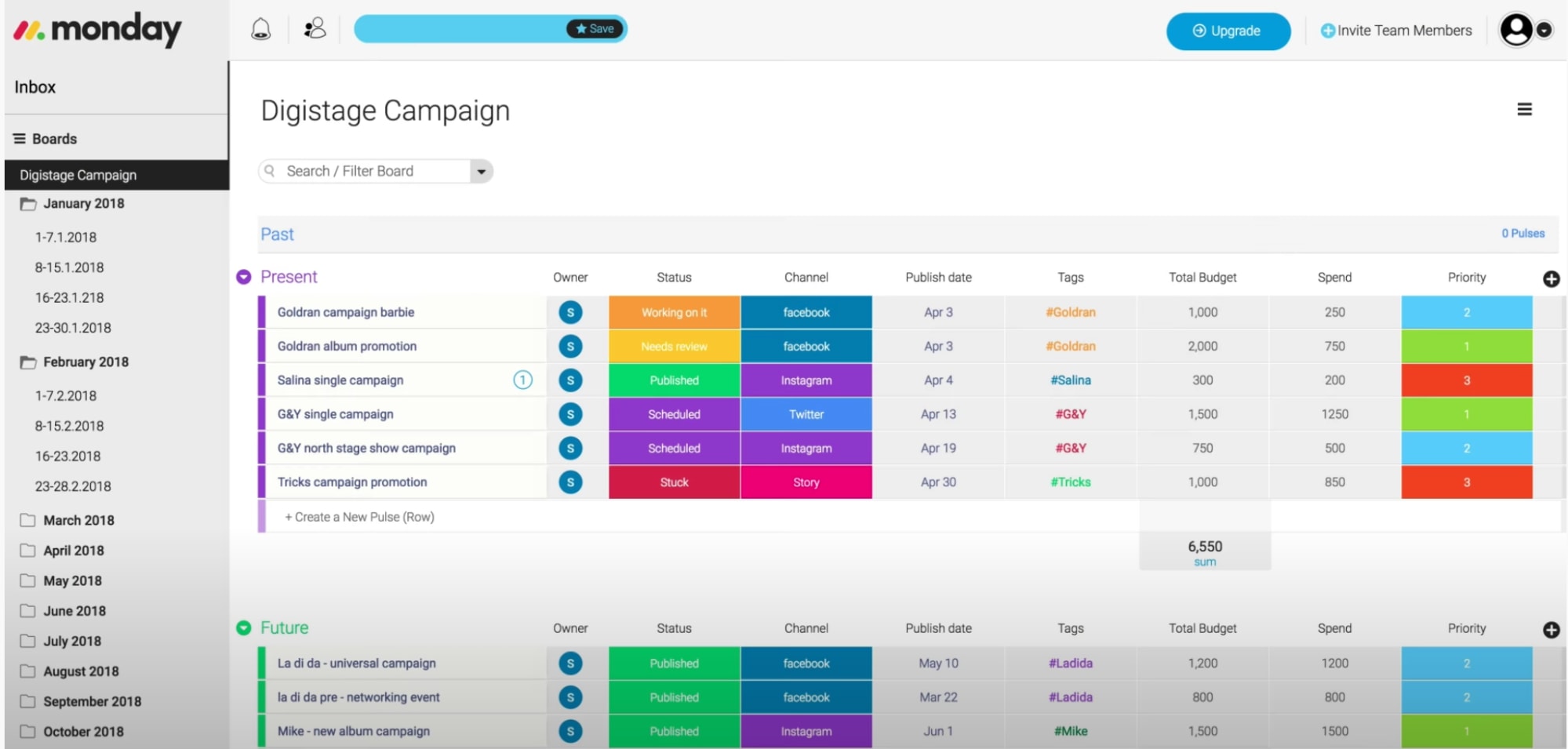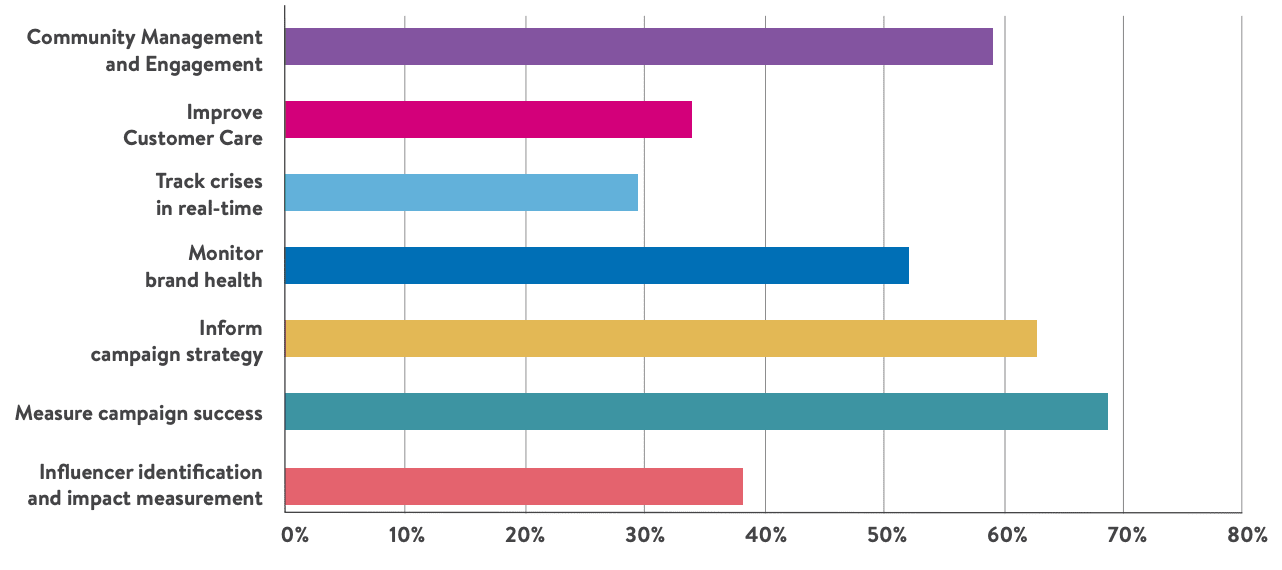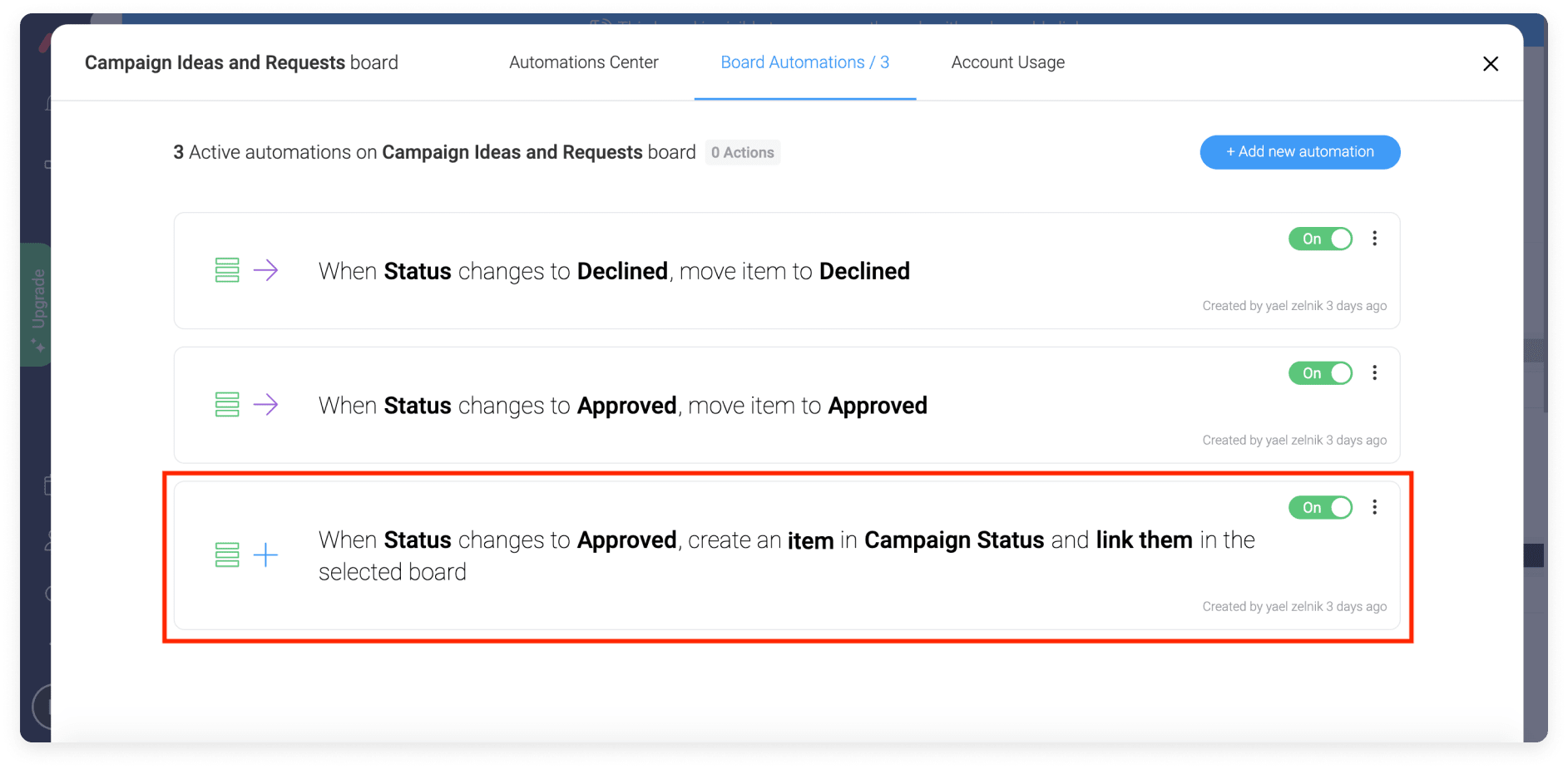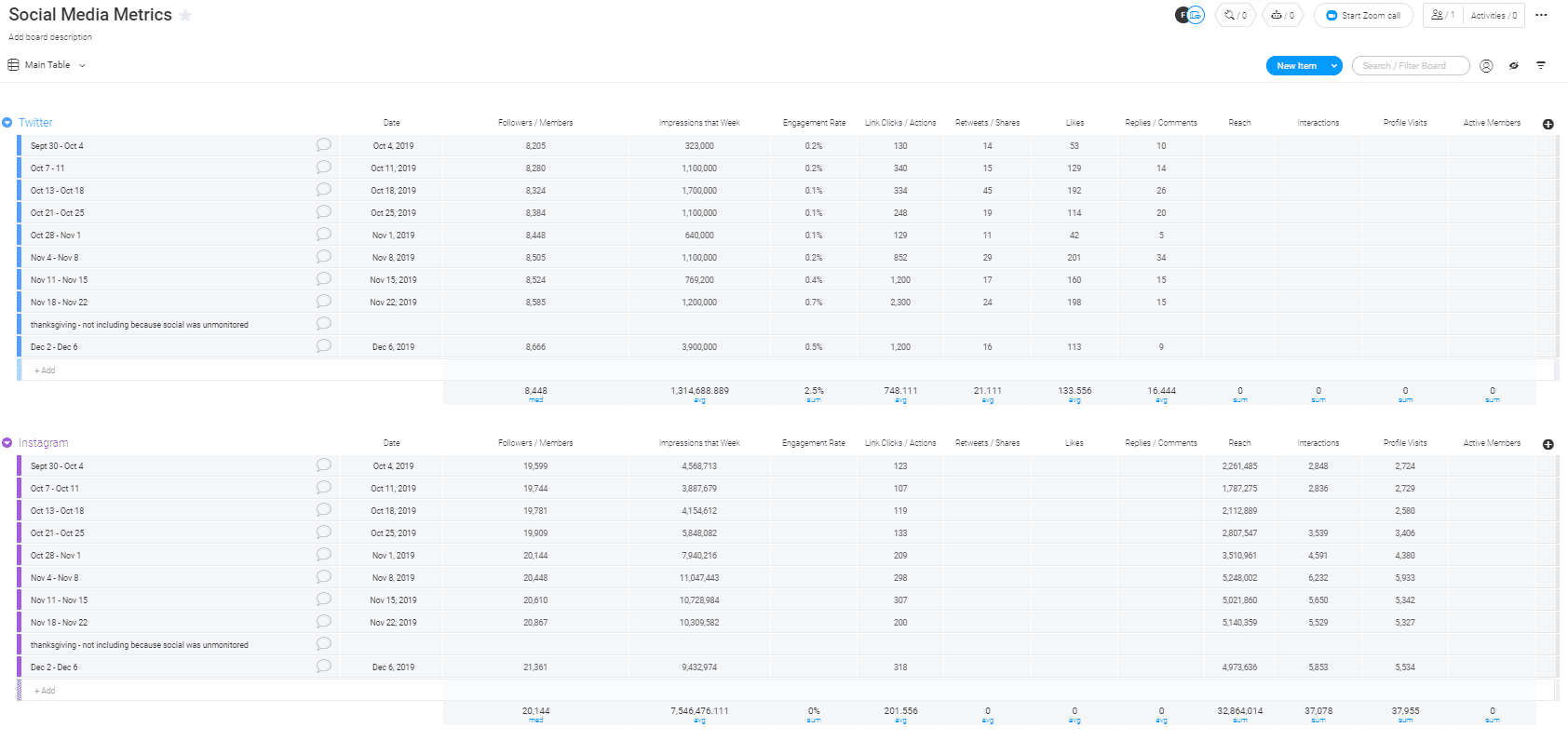What’s the difference between a fish and a poor social media manager?
Nothing. They both flounder.
If you don’t have your social media tools and best practices in check, you’ll be drowning in subpar campaigns and missing opportunities for growth.
But, what exactly do you need to take your social media marketing by the horns and finally take control?
Read on to discover the top 2023 social media management best practices and exactly how to achieve these with monday.com.
What does social media management entail?
In short, you can sum social media management up as ‘everything to do with your social media.’
From the ideas to the execution, the social media management umbrella covers every aspect of campaign planning, production, distribution, and measurement on each and every social media channel.This includes tasks such as:
- Analyzing your target audience to identify targetable behaviors
- Building a social media strategy and calendar
- Devising concepts for content and content creation
- Scheduling and distributing social media posts
- Creating and updating social media profile information
- Monitoring online conversations and communicating with customers
- Social listening and analyzing social media behavioral data
- Managing influencer marketing (you can use influencer marketing solution Find Your Influence to help build find the right influencers for you to get the results you want. When finding influencers, be sure to review their followers’ demographics and interests to ensure they align with your target audience.) There are over 37 million influencers on Instagram, but you should only work with the ones that are highly relevant to your niche, products, and brand.
- Measuring and monitoring campaign performance and community engagement
That’s a lot to juggle.
But the payoff is worth it. If you really nail your social media management, your campaigns will run like clockwork, and you’ll see profound results in your social engagement.
According to marketers who’ve been using social marketing for 1 year or more, 80% say it’s increased business exposure, while half say it’s helped them improve sales. In fact, 73% of those in social media marketing believe it is effective to promote products or services.
The problem is — if you drop the ball — it could all come crashing down.
If you don’t have the right social media management tool to make sure your social media marketing stays on track, you’ll start to neglect your schedule. Here’s a list of social media management tools that you could use to boost your marketing efforts
This will make it tricky to glean important customer data, communicate with customers, and build influencer marketing opportunities.
As a result, this could impact your reputation, and your campaigns won’t perform as well.
That’s why smart teams use monday.com to handle social media management.

As Aviv Luski, CEO at Digistage, explains, “I really needed something very fine, very simple, and well-designed, and monday is perfect.”
The social media agency uses the monday.com’s Work OS for all their social media efforts — building out campaigns, organizing content production, prioritizing tasks, and monitoring performance.
As Aviv puts it, “Every day would actually crash without monday. Seriously.”
Here are the top 5 brand new 2023 social media management best practices
You know the drill — target your audience, post at the right times, schedule your content, blah blah blah.
Of course, all those tried-and-true management rules still stand.
But, if you really want your social media to kill it this year, you need to add these updated social media management best practices to your playbook
1. Anticipate changes in audience behavior
More than half of customers expect that brands will anticipate their needs and deliver personalized services that meet those needs.
The problem is that most brands build a target persona once and don’t account for changes in audience behavior.
Just look at the rise of TikTok.

Pre-2019, TikTok was hardly a prominent platform in anyone’s campaign. Then it boomed, and social media users everywhere flocked to download it.
These kinds of behavioral fluctuations are common in the social media world, and you need to keep up-to-date to make sure you’re tailoring your campaigns to accommodate these changes. Planning your campaigns ahead of time in a social media calendar can help you stay on top of every news and updates that happen.
But it’s not just social media platform fads you need to look out for.
From trending social media challenges to feature updates, the way that your audience behaves on social media is constantly changing. You’ll need to keep up with these fluctuations to make sure your campaigns stay current.
You do this by social listening and tracking analytics data.

63% of social media marketers use this data to inform their social media strategy, while 60% use it to manage community social engagement.
Not only can you track brand and industry mentions to keep a foot in the conversation, but you can also keep an eye on the campaigns that create the biggest stir. This will help you build more relevant and appealing content.
Remember, this data isn’t just helpful for generating social media content — you can transfer what you’ve learned to inform content on other platforms. In fact, 85% of companies that do this feel far more confident about the ROI of their social media campaigns.
2. Increase your brand’s transparency
86% of Americans believe that it’s more important than ever that brands are transparent.
In fact, buyers now think it’s a brand’s duty to be open and honest, with 81% of consumers agreeing that companies have a responsibility to be transparent on social platforms.
Thanks to the increased dominance of social media and the 2-way conversation it generates, brands are now held accountable in ways they never could be before.

This rise in accountability has led to more than half of social media users claiming they’ve publicly called out a company for doing something wrong.
But rather than get caught short doing something underhand, it’s better to be transparent with your audience about your company’s values and practices.

Consumers want brands that display honesty, clarity, openness, authenticity, integrity, and good communication.
But here’s the best bit. The results of transparent behavior are tangible.
Nearly 90% of buyers are more likely to give transparent brands a second chance after a bad experience.

Likewise, more than half of customers are more likely to consider purchasing from brands that are transparent on social media, and 42% are likely to recommend them to a friend.
On the flip side, if your brand lacks transparency, 86% of buyers are likely to pick your competitor.
3. Build social commerce experiences
As Digital Marketing Coordinator for Penguins Events and Incentives, Maisie Tomlinson, puts it:
“Brands want to convert customers as soon as possible, therefore why waste time sending them to your website, for them potentially to leave because of user experience issues. Reduce drop-offs by selling directly from your social media post.”
Now that social media platforms have made it possible to sell goods directly from your social media account, it’s important that you make it easy for them to purchase with an Instagram or Facebook Shop. Ensure that your account is optimized so that you monetize consistently.
After all, 70% of shoppers already head to Instagram to discover new brands — you might as well catch them while they’re in the market to buy. To do that, you need to learn how to sell on Instagram.

To facilitate social commerce, you need to start building social media sales funnels that encourage users to convert directly on your social profile.
Try these techniques:
- Adding product polls and quizzes to your Instagram and Facebook stories
- Create boards in Pinterest that lead straight to your Facebook and Instagram shops
- Direct your paid-for ad campaigns to your social media shops & create esthetic Instagram grids with shoppable links & product photos
- Send automatic chatbot messages that send your followers promotions
- Have influencers endorse and tag your products on your social profile
4. Take a stand with your customers
They say you should never talk about religion, politics, or sport in a bar. It’s the exact opposite when it comes to social media in 2023.
If you’ve got something to say about an issue, speak up loud and clear.
56% of consumers don’t respect brands that choose to stay silent on key issues.

In fact, consumers want quite the opposite. They want brands that take social action and use their social profiles as a soapbox for these values.
Not only does it help your customers align with you, but it also increases sales and referrals.
One in 5 customers says that a brand’s positive actions will affect their purchasing behavior, while more than a third of customers say that if they’re going to recommend a brand, the most important trait is shared values and ethics.
As Maisie Tomlinson explains:
“In 2021, consumers will be looking for more meaningful content that they can share to educate others. Brands that have a defined opinion on equality or feminism, but don’t do anything about it, will be criticized for their lack of action.”
In this vein, if you want to rally the troops, find the causes your customers believe in and show your support on social media with educational and actionable content.
5. Alter your audience’s reality
Augmented (AR) and virtual reality (VR) are creeping into social media at a rapid rate. From branded Snapchat filters to virtual reality tours, AR and VR will reshape the way users interact with social platforms.
For example, Instagram recently announced its new feature that gives brands the functionality to let customers try on products before purchasing them on Instagram.

Working like an Instagram filter, this augmented reality tool means that brands can finally give customers an in-store experience online.
Alternatively, use AR and VR to spread brand awareness like Warner Bros did with the Shazam movie.

Snapchatters simply had to scan in the QR code and say ‘OK Shazam’ to trigger the world’s first voice-activated Snapchat filter.
While a little gimmicky, this entertaining filter put this movie on the tip of the audience’s tongue. Literally.
Think about ways you can incorporate AR and VR into your social media campaigns.
Consider working in:
- A branded Snapchat filter
- A Facebook 360 video tour
- ‘Wearable’ Instagram products
How monday.com makes social media management a piece of cake
Without monday.com, your social media management is going to resemble that pile of coat-hangers at the bottom of your wardrobe.
Instead, let’s get everything in order, so your brand always steps out on social media dressed to impress with every post.
Here are 3 ways to iron out the wrinkles in your social media management with monday.com.
1. Managing social media campaign ideas and requests
As social media best practices become ever-more creative, the campaign ideas will start flooding in.
Manage all your social media marketing campaign requests and ideas in one place using the monday.com Work OS.
Start by using this template to organize and manage social media campaign requests.

You can create customized forms that your team fills in, which will automatically populate your social campaign ideas dashboard.

Automate the management of these ideas using monday.com’s “Automation Recipes.”
Set up an automation to automatically move approved requests to your social media content calendar. That way, new ideas head straight into the content creation workflow.
2. Planning and tracking social media campaigns
Every social media manager needs a centralized social media calendar to keep the social media team on task.
This social media calendar template can help you plan your content for you and your team.

The highly-visual dashboard keeps everyone focused and allows you to prioritize tasks and track campaign progress in real-time.
Not only that, but you can integrate your social media platforms with monday.com to schedule posts to release automatically.
3. Measuring social campaign performance
Don’t leave your campaigns to guesswork. Find out exactly what your audience likes and doesn’t like by tracking campaign performance.

Import social media analytics data into this template to monitor campaign performance across all your social media networks. This will help you to identify patterns to inform your next campaigns.
You can even integrate your Facebook Ads account with monday.com’s Work OS to measure ad performance without flicking between social media tools.
Social media management means everything stays on track
When it comes to social media management, the juggle is real.
With multiple social media accounts and endless campaigns to manage, you’ll struggle to get everything produced and out on time if you don’t have a social media management tool in place to manage these tasks.
Not only that, but if you’re not keeping a keen eye on campaign performance, you’ll never learn what’s hot and what’s a flop.
That’s why top brands use monday.com for social media management. With everything in one place, the whole social media team stays on track, and campaigns are delivered on time, every time. Try it today.

